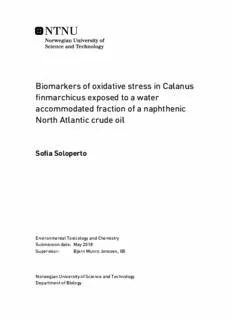
Biomarkers of oxidative stress in Calanus finmarchicus exposed to a water accommodated fraction PDF
Preview Biomarkers of oxidative stress in Calanus finmarchicus exposed to a water accommodated fraction
Biomarkers of oxidative stress in Calanus finmarchicus exposed to a water accommodated fraction of a naphthenic North Atlantic crude oil Sofia Soloperto Environmental Toxicology and Chemistry Submission date: May 2018 Supervisor: Bjørn Munro Jenssen, IBI Norwegian University of Science and Technology Department of Biology Sofia Soloperto Biomarkers of oxidative stress in Calanus finmarchicus exposed to a water accommodated fraction of a naphthenic North Atlantic crude oil Master’s thesis in Environmental Toxicology and Chemistry Trondheim, May 2018 Supervisor: Bjørn Munro Jessen Co-supervisor: Tomasz Maciej Ciesielski Co-supervisor: Elise Skottene Norwegian University of Science and Technology Faculty of Natural Science Department of Biology Acknowledgments This master thesis was written at the Department of Biology, Norwegian University of Science and Technology (NTNU) in Trondheim, 2018, and was financed by GRACE project (Integrated Oil Spill Response Action and Environmental Effect), supported by the EU Program Horizon 2020 under the grant agreement no. 679266. I would like to thank my main supervisor, Bjørn Jessen, for his exhaustive help in the final stages of my master thesis. A big thanks to Elise Skottene for guiding me through the lab work and for being always present and helpful. Thanks to Dag Altin for his priceless help during the experimental phase, and to Torfinn Sparstad and all the Post Doc and PhDs students working in his lab for listening to my thousands questions and helping me during the lab work. A special thanks goes to Tomasz Maciej Ciesielski for his endless support and trust; you made the whole journey a lot funnier! A big thanks to Berta and Ieva for our late-night, semi-scientific discussions that made us feel like real scientists. Finally, a big thanks to my family and all my friends, near and far, for always being there! iii iv Abstract Calanus finmarchicus is an ecologically important species in the North, Norwegian and Barents Seas, periodically constituting up to 90% of the standing stock of zooplankton. Due to continued development of areas for oil and gas production, there are environmental discharges of contaminants occurring both continuously and accidentally in these areas. Existence of reliable biomarkers for oil exposure are fundamental for monitoring programs and decision-making processes in case of environmental discharges and oil spills. To assess the potential negative effects of oil exposure on keystone component of marine ecosystems, adult females of Calanus finmarchicus were exposed to a water-accommodated fraction (WAF) of a naphthenic North Atlantic crude oil. Adult non-ovulating females from the continuous lab culture at SINTEF/NTNU Sealab, were exposed without feeding to sub-lethal concentration of WAF in seawater and collected at 5 different time points: 0, 24, 48, 72 and 96 hours. Several oxidative stress biomarkers were tested with gene expression (qPCR), enzymatic activity analyses, determination of glutathione (GSH) and lipid peroxidation assay for malondialdehyde (MDA) concentration. Our results demonstrated induction of glutathione S-transferases (GST) and increase of GSH and MDA concentrations in the exposed group at each time point sampled. Gene expression results showed inconsistent responses with both up- and downregulation of GST at 48 and 72 hours and downregulation of superoxide dismutase (SOD) at 72 hours. Our study indicates that GST enzymatic activity, and GSH and MDA concentrations can be applied as effective biomarkers of oxidative stress in C. finmarchicus, while gene expression of SOD and GST are less suitable. v vi Table of Content 1 INTRODUCTION ............................................................................................................ 1 1.1 MARINE OIL POLLUTION .................................................................................................. 1 1.1.1 Petroleum chemical components ............................................................................ 3 1.1.2 Petroleum physical properties ............................................................................... 4 1.1.3 Petroleum faith in the marine environment ............................................................ 5 1.2 OIL SPILLS....................................................................................................................... 7 1.2.1 Overview ................................................................................................................. 7 1.2.2 Acute and chronic toxic effects ............................................................................... 8 1.2.3 Effects of oil pollution on planktonic community ................................................... 8 1.3 OXIDATIVE STRESS .......................................................................................................... 9 1.3.1 Biomarkers of oxidative stress ............................................................................. 11 1.4 CALANUS FINMARCHICUS .............................................................................................. 12 1.5 AIM OF THE PRESENT STUDY ......................................................................................... 13 2 MATERIAL AND METHODS ..................................................................................... 14 2.1 TEST SPECIES AND EXPERIMENTAL SET-UP .................................................................... 14 2.2 EXPOSURE MEDIUM ....................................................................................................... 15 2.3 SAMPLING ..................................................................................................................... 15 2.4 CHEMICAL ANALYSIS .................................................................................................... 17 2.5 GENE EXPRESSION ......................................................................................................... 17 2.5.1 RNA extraction ..................................................................................................... 17 2.5.2 cDNA synthesis ..................................................................................................... 19 2.5.3 qPCR .................................................................................................................... 21 2.5.3.1 Primers selection .......................................................................................... 21 2.5.3.2 Procedure ...................................................................................................... 24 2.5.4 Data handling ....................................................................................................... 24 2.6 ENZYMATIC ASSAYS AND MDA AND GSH CONCENTRATIONS ...................................... 25 2.6.1 GSH determination ............................................................................................... 25 2.6.2 MDA level ............................................................................................................. 26 2.6.3 Enzymatic activities .............................................................................................. 26 2.7 STATISTICS .................................................................................................................... 27 3 RESULTS ......................................................................................................................................... 28 vii 3.1 OIL AND WAF PROFILE ................................................................................................. 28 3.1.1 Volatile Organic Compounds ............................................................................... 28 3.1.2 Semi-Volatile Organic Compounds ...................................................................... 28 3.2 QPCR ............................................................................................................................ 30 3.3 ENZYMATIC ASSAYS AND MDA AND GSH CONCENTRATIONS ...................................... 32 4 DISCUSSION .................................................................................................................................. 35 4.1 WAF TOXICITY ............................................................................................................. 35 4.2 GENE EXPRESSION OF GST-2 AND SOD AS BIOMARKERS.............................................. 36 4.3 ENZYMATIC ACTIVITY OF GST AND CONCENTRATION OF GSH AND MDA AS BIOMARKERS ......................................................................................................................... 40 4.4 GENE EXPRESSION VS. ENZYMATIC ACTIVITY AND MDA AND GSH CONCENTRATIONS 41 4.5 EXPERIMENTAL DESIGN AND ANALYSES LIMITATIONS................................................... 42 4.6 IMPLICATION OF THE PRESENT STUDY ........................................................................... 44 5 CONCLUSION ............................................................................................................................... 45 REFERENCES ........................................................................................................................................ 46 APPENDICES .......................................................................................................................................... 58 APPENDIX I: DETERMINATION OF LC50 CONCENTRATIONS OF NAPHTHENIC NORTH ATLANTIC CRUDE OIL WAF IN C. FINMARCHICUS ................................................................................... 58 APPENDIX II: QPCR SET-UP ................................................................................................... 59 APPENDIX III: OIL AND WAF PROFILE – VOC ...................................................................... 60 APPENDIX IV: OIL AND WAF PROFILE – SVOC ................................................................... 61 APPENDIX V: AVERAGE CT VALUES FOR ACTIN AND EFA1Α ................................................ 64 APPENDIX VI: EXPRESSION RATIO OF TARGET GENES ........................................................... 65 APPENDIX VII: ENZYMATIC ASSAYS AND MDA AND GSH CONCENTRATIONS ...................... 67 APPENDIX VIII: NORMALITY TEST ........................................................................................ 69 APPENDIX IX: RESULTS FROM STATISTICAL ANALYSIS ......................................................... 71 viii
Description: